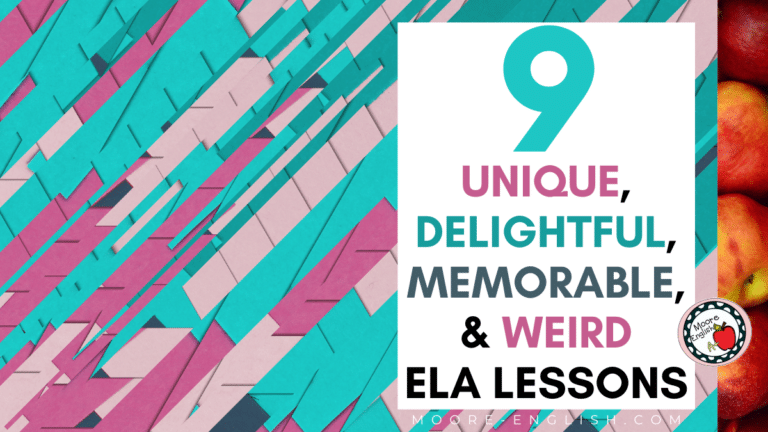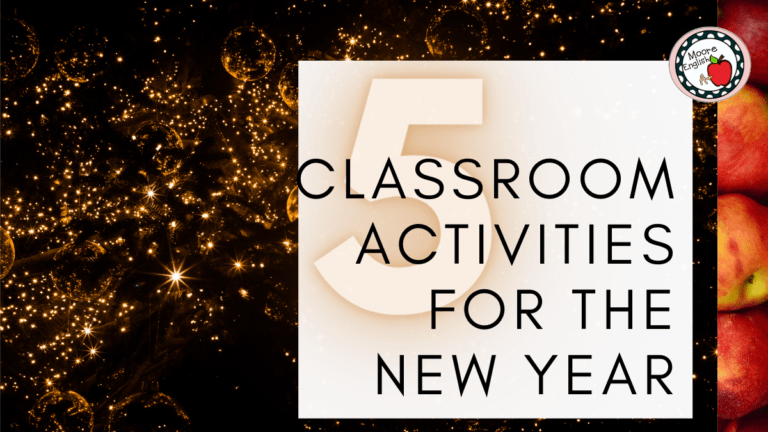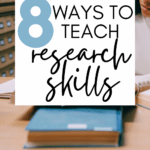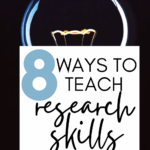While students often struggle to see the relevance of poetic meter or mythological allusions, they can usually appreciate the value of developing research skills. With the glut of information readily available, students often understand the value of being able to determine which information is reliable and which is not. Even as students soak up social media, it’s important for them to think critically about where information comes from, how it’s transmitted, and who it benefits.
However, research can also be an overwhelming proposition for students. Sometimes they struggle with where to begin. Sometimes their research interests are so broad and varied they struggle to narrow down the scope of inquiry. And sometimes students grow frustrated with finding sources that match their hypothesis.
To help students develop their research skills, I have put together 8 fresh, fun ideas for teaching research skills.
Introducing the Research Process
For students, the concept of “research” is often nebulous. For teachers and academics, a lot of the steps in the research process come naturally or have become second nature. It can be easy to forget how long it took us to hone our research skills. With this in mind, it’s important to help students break down the research process into manageable steps.
To help gamify this experience, I have created a card sort to help students manipulate the steps in the research process. Since I have students at different levels, I have included wayyyy more steps than students ever need, but that makes it easy for me to differentiate between groups of students and their needs. Some classes need to focus on the the steps that happen before conducting research. Other groups need to spend more time focused on the process of conducting research.
Bell work is also a great way to introduce research skills. As students enter a unit that focuses on research skills, I will use these research task cards as bell work and exit tickets. This is a great way for me to gauge students’ abilities and prior knowledge. This is also a good way for me to gently introduce research without causing a panic.
Finally, once students have some experience with research skills, it’s important to practice determining a source’s credibility. This source credibility card sort is a fun way to help students practice this skill! If you’re pressed for time, this credibility book mark is a quick reminder for students!
Scaffolding Research Skills
My dad often asks, “How do you eat an elephant?” The answer: one bite at a time. This is the perfect mindset for teaching research skills. Here are some strategies to scaffold the research process.
First, unpack the process of writing research questions.
- Model the process of writing a research question.
- Give students a research topic and ask them to work with a partner to write a research question.
- Post the questions around the room, and ask students to complete a gallery walk providing one another with feedback on their research questions.
Similarly, before students engage in large-scale research, find ways to incorporate small research projects. For example, students could research the historical context of a text before they read it. This gives students an opportunity to practice research skills on a small scale before they’re asked to try anything more significant.
For example, my students complete research about the historical context of To Kill a Mockingbird and The Great Gatsby. This gives students time to familiarize themselves with the library’s research tools. They also practice generating search terms and research questions. Once students have a piece of credible research, they use this free collection of graphic organizers to unpack their research. Using graphic organizers is a great scaffold for students.
To practice correct citations, students will then create an annotated bibliography entry for their source. Each student will create their entry in a shared Google Slides presentation, which allows students to see one another’s work and to, in this case, learn about the historical context of our class novel.
Another great graphic organizer for scaffolding research skills is this one that focuses on the difference between quotations, paraphrases, and summaries. This is great for review and for introducing these nuances!
Setting Up Longer Research Projects
At the end of the day, students are always working toward a larger piece of research. In the language arts classroom, that project is often a research paper. Regardless of how you personally feel about teaching the research paper, they remain a staple in many secondary and collegiate classrooms.
In the interest of making the research process more engaging for students, teachers often leave topic selection wide open, encouraging students to research any topic they desire so long as it is school appropriate. I would argue that this approach is often not the best. Instead of providing unlimited choice, use a research unit to support another unit of study. This has a few advantages:
- First, it eliminates the likelihood of a student choosing an inappropriate or weak topic.
- Second, it gives librarians an opportunity to pull together collections of related materials to support students.
- Most importantly, it provides students with opportunities to research collaboratively. If students have similar subjects, they can share research questions, search terms, and sources.
Here are some ways to create engaging research topics within the language arts classroom:
- When preparing to read To Kill a Mockingbird, consider asking students to research different instances of injustice. “Injustice” is such a wide topic that students will have plenty of choice but plenty of ground for collaboration.
- If you’re preparing to read The Great Gatsby, consider asking students to research the development of the American Dream.
- In my world literature class, we often read creation stories, so for our research paper, we went the other direction and investigated different ways the world could end.
- When preparing to read one of Shakespeare’s dramas, consider challenging students to investigate entertainment, communication, gender roles, mental health, etc. There’s so much fertile ground in the realm of Shakespeare that students could choose from a variety of topics.
- If you’re preparing to read Beowulf, encourage asking students to research famous heros, the evolution of the word “hero,” or the development of the hero’s journey.
How do you make research skills fun and fresh for students?















